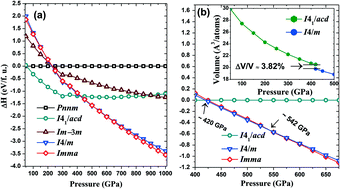Pressure induced evolution of structures and properties of iron tetraboride
Abstract
Iron tetraboride (FeB4) is attracting increasing attention due to its attractive electronic and mechanical properties (e.g., superconductivity and superhard). Using particle swarm optimization (PSO) combined with first-principles calculations, we systemically studied the structural phase and properties of FeB4 up to 1 TPa. Our results revealed, unexpectedly, that pressure stabilizes two hitherto unknown I4/m (420–542 GPa) and Imma (>542 GPa) structures. Under compression (0–1 TPa), for the first time, we identify that the structural phases of FeB4 transform initially from Pnnm to I41/acd, I4/m, and finally to Imma. During these transformations, the evolution of a boron framework is from a graphene-like layer to a tetrahedral B4 cluster, one-dimensional B4 cluster-chain, and interconnected graphene-like network, where the number of B–B bonds for each B atom gradually increases from 3 to 4, 5 and 6, respectively. Among these phases, a remarkable feature of the Fe atoms is that their coordination number changes from an 8-fold coordination to unexpected 12-fold coordination with increasing pressure. By the analysis of electronic structures, a feature is revealed that the electrical properties of FeB4 evolve from those of a superconductor to a semiconductor, and a conductor in the range of 0–1 TPa. Moreover, the mechanical property calculations indicate that these phases of FeB4 all exhibit excellent mechanical behaviors and are expected to be superhard materials. These results expand the knowledge of FeB4 and stimulate further interest in exploring it from a high pressure perspective.



 Please wait while we load your content...
Please wait while we load your content...